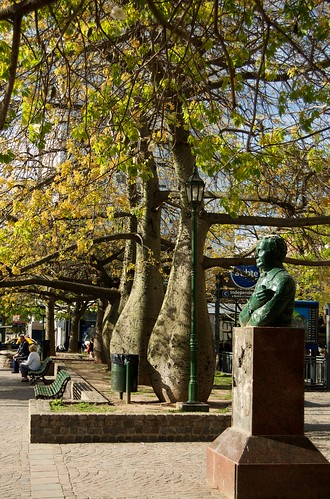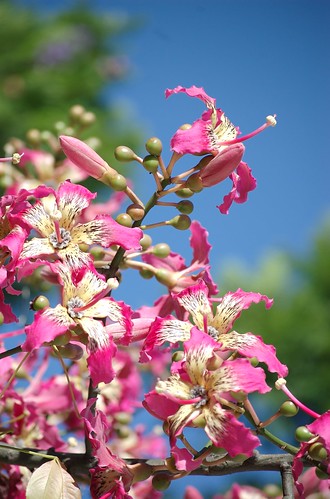In my research about the trees of Argentina, I have come across some legends and I thought I would share one of them now. This is from Bolivia and is about the Palo Borracho or - El Toborochi - as it's known there. I've translated this as best I could from here. I'm pretty sure that the words in parentheses are Guarani. If anyone knows of more, please let me know! I love reading these stories.
-----------------------
A long time ago, when gods lived on earth as people, the dark spirits (Aña) abused the early Guarani people, killing the men and stealing their women.
In a small village lived a beautiful young woman named Araverá "Sparkle in the sky", the daughter of the grand chief Ururutï "White Condor". She recently married the hummingbird god, Colibrí, (Chinu tumpa), and hoped to soon have a son, who would grow up to be the best Shaman (Paye) of the area, capable of destroying all of the evil spirits.
The Añas got wind of her plans and schemed to kill her, without any consideration for Araverá. They mounted their fire-breathing winged horses and pointed them to her small town; but Araverá, saw what danger she was in and escaped, flying to the ultimate ends of the universe in her tiny flying chair that her husband Colibrí gave her.
The Añas pursued her everywhere, the the depths of the waters, under the earth, and higher than the stars. When her tiny flying chair finally couldn't support the weight of her and her growing baby anymore, they descended to earth and hid inside a Toborochi (Samou), and the Añas passed them by and never found them. There inside, Araverá bore her son. The boy grew and took revenge upon the evil of the Añas, but his mother remained in the trunk of the Samou, as she does to this day. Sometimes, when she does go outside, she becomes the tree's beautiful flower, so that the hummingbirds can come and enjoy her nectar.
May 5, 2009
Palo Borracho / El Toborochi
Labels:
Guarani,
legend,
palo borracho






2 comments:
What a beautiful myth! I agree - these types of stories are interesting. Unfortunately I don't know of any others to share. :(
Also, chamán is "shaman" and "cacique" is chief. :)
thanks Katie! I updated the translation with your help. I figured that chamán was shaman, but didn't bother to translate it - fixed now. ;)
I have bookmarked some legends that I have found on delicious, but am always on the lookout for more.
Post a Comment